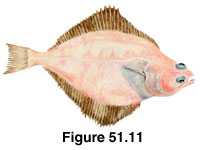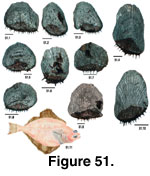 Description
Description
Hippoglossoides elassodon
(Flathead Sole)
(Other common names: Paper Sole, Cigarette Sole)
Figure 51.11
 Description
DescriptionLength: 46-50 cm.
Mouth: large, terminal; wide gape; near symmetrical; lower jaw protrudes; teeth in both jaws and well developed; teeth in upper jaw in a single row; maxillary extending to a point below pupil.
Body: compressed/thin; narrow raised interorbit space between two large eyes; caudal peduncle slender; caudal fin truncate with small V-shaped extension; small pores below the lower eye; well developed anal spine at base of anal fin; dorsal branch of lateral line absent; pectorals large and tips are rounded.
Color: grey to olive brown on eyed side; white on blind side, dusky blotches on dorsal and anal fins; sometimes dusky blotches on body.
Depth: up to 550, but most common 275-366 m; young in shallower water with adults generally below 180 m; over-winter along the outer shelf and move to shallower water in the spring.
Habitat: silty-muddy substrate.
Season: spawns in spring (March- April).
Diet: molluscs, echinoderms, fish, and polychaetes.
Predators: not determined.
Distribution: central California to the Bering Sea to the Sea of Japan.
 Scale Description
Scale DescriptionScale Type: predominately ctenoid on eyed side and cycloid on blind side.
Relative Scale Size: small.
Position of Scales on Body: in a band across the lateral line and in a diagonal row between the dorsal fin and the lateral line at widest part of body; also on caudal peduncle; imbricated; decidous (Hart, 1973).
Overall Scale Shape: variable; some circular, others semi-circular with the posterior fields being short and the edge being straight; leading edges can be uneven.
Focus and Circuli: the focus abuts the inside edge, approximately one-sixth of the total scale length from leading edge of the posterior field (Batts, 1964). The circuli are tightly packed and generally appear continuous (except where broken by radii). In the posterior field, the circuli are truncated by ctenii region.
Radii: numbers are variable and not diagnostic. The radii are primarily in the anterior field, but in some regenerated scales, they also appear in the lateral fields (radii not present in all fields, Batts, 1964). The leading edge of the radii are slightly scalloped. Intermarkings absent (Batts, 1964). Area of anterior field larger than area of combined lateral fields (Batts, 1964). There is no bar-like thickening anterior to base of ctenii (Batts, 1964).
Note: Batts, (1964) stated that the posterior field is not well demarcated and that some normal circuli do extend into the posterior field. This does not appear to be the case with our reference collection. It is not certain if this is a plastic feature, or due to desiccation of the reference material.